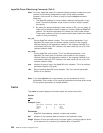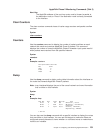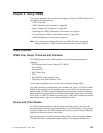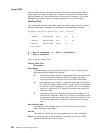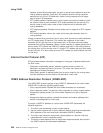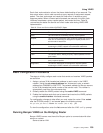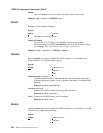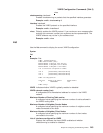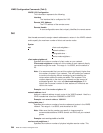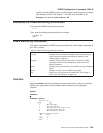updates, spaced 90 seconds apart, are sent to the services nodes that sent the
routing response packets. Once the X.25 interface receives routing response
packets from all of the X.25 destination nodes, routing requests are no longer
sent to those X.25 addresses.
v
RTP update packets.
Packets sent by client nodes to the service nodes to notify
the service nodes of their existence. RTP update packets are also sent by the
service nodes to notify other nodes of their existence and to advertise their
routing databases.
v
RTP response packets.
Packets service nodes send in response to RTP request
packets.
v
RTP redirect packets.
Informs the nodes of the best paths between them for
routing packets.
Unless connected by a permanent circuit, every client and service node broadcasts
an RTP update every 90 seconds. This notifies the neighbors of the node’s
existence and its type (service or client node) and, in the case of service nodes,
advertises their routing databases. When a router receives an update packet from a
service node, RTP extracts the VINES IP address and looks in the routing table for
an existing entry on that service node. If it exists, RTP updates the entry and resets
the entry’s timer. If an entry does not exist, RTP creates one and initializes the timer
for that entry.
Internet Control Protocol (ICP)
ICP generates network information messages on two types of packets destined for
the local router:
v
Destination unreachable packet.
Indicates a packet could not reach its
destination and was returned to its source. The router then issues an ELS
message and flushes the packet.
v
Delay metric packet.
A request packet from a source node for the routing metric
from the destination service node to the destination client node.
VINES Address Resolution Protocol (VINES ARP)
The VINES ARP protocol assigns unique VINES IP addresses to the client nodes.
VINES ARP includes the following packet types:
v
Query request packet.
Packets the client nodes broadcast on initialization.
v
Query response packet.
The service node’s response to a query request packet.
v
Assignment request packet.
The client node’s response to a query response
packet.
v
Assignment response packet.
Includes the network and subnet addresses the
service node assigned to a client node.
To assign a VINES IP address to a client node, VINES ARP implements the
following algorithm:
1. The client node broadcasts a query request packet.
2. Service nodes respond with a query response packet containing the destination
MAC address of the client node and a broadcast VINES IP address.
3. The client node issues an assignment request packet to a service node that
responded with a query response packet.
4. The service node responds with an assignment response packet that contains
the VINES network and subnetwork addresses.
Using VINES
238
MRS V3.2 Protocol Config Ref Vol 2



